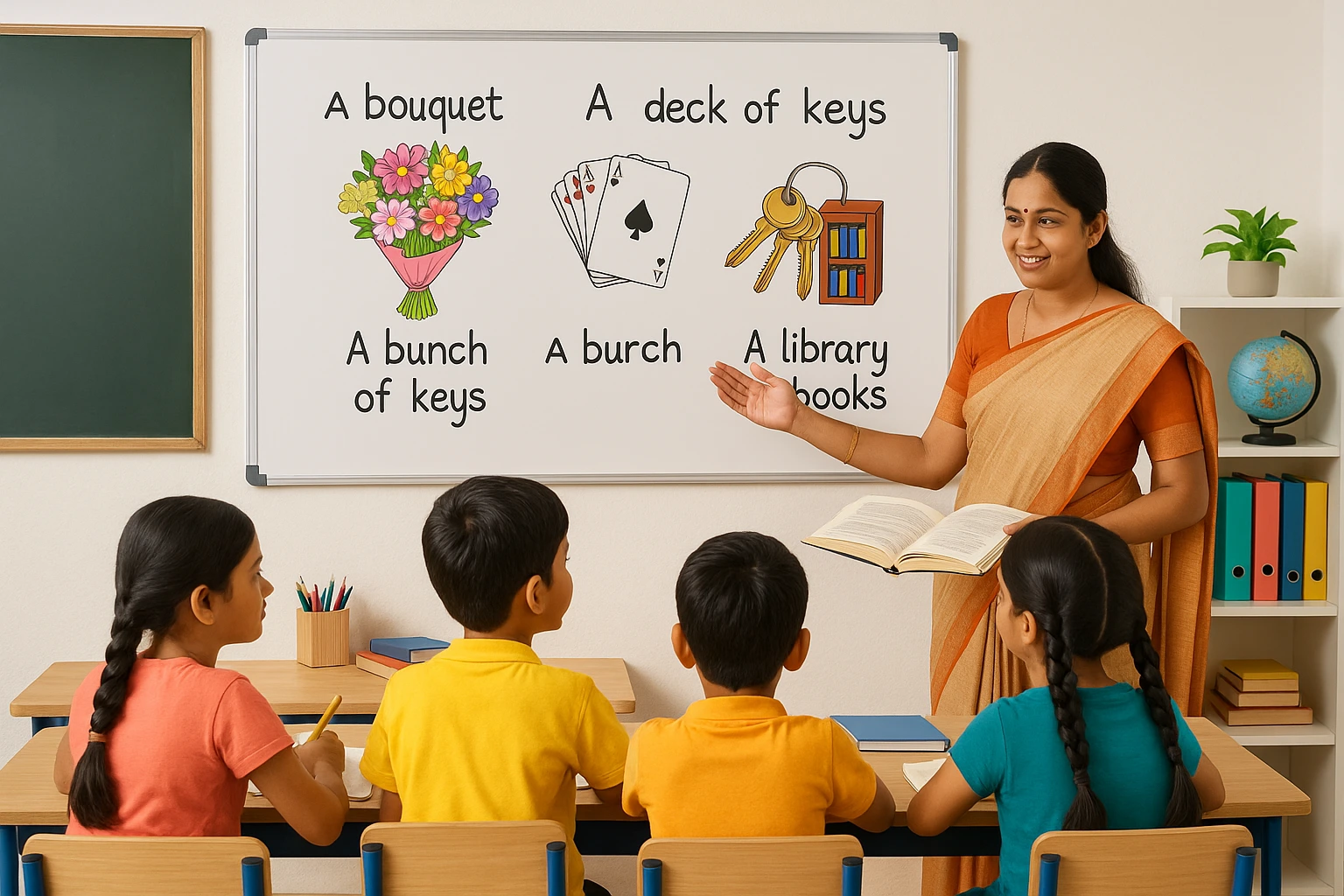
A Collective Noun is a word that names a group of individuals, animals, or items seen as a single unit. We use a single word to speak about the whole group instead of listing each person, for instance- a library of books or a team of players. Understanding Collective Nouns makes it easier to define groups of items or individuals together clearly.
Discover the Power of Words that Represent Groups
A noun is a word that names a group of individuals, animals, or items and considers them as one unit. Discover the Power of Words that Represent Groups as these words form important tools in language that let us talk about a collection in a straightforward manner.
Why Use this Nouns?
Using helps:
- Reduce repetition in writing
- Make communication clearer
- Replace lengthy group descriptions with single-term
- Instead of saying, “the bouquet of flowers,” you can simply say “the bouquet.”
Everyday Examples:
For People:
- Team
- Family
- Class
- Group
For Animals:
- Herd (e.g., of cattle)
- Flock (e.g., of birds)
- Pack (e.g., of wolves)
For Things:
- Bouquet (e.g., of flowers)
- Deck (e.g., of cards)
- Collection (e.g., of stamps)
How Are They Used?
These Nouns consider the group as one unit and hence usually take a singular verb.
- Correct: The class is ready for the test.
- Not commonly used: The class are ready for the test.
Using these Nouns accurately adds both clarity and variety to writing. Whether depicting a group of people, animals, or things, these words function as a simple yet effective linguistic shortcut.
To download brochure of Best Grammar Course, Click Here!
For more information of Best Grammar Course Call / Whatsapp on +919869546913/+919869866277

Source: thegingerteacher
Simple Grammar Guide for Kids, Students and English Learners
Grammar is the set of rules that support correct sentence formation. It teaches how words balance each other so that we can convey ideas clearly. Learning grammar doesn’t have to be tricky. With the right approach, anyone can develop adept language skills.
Key Grammar Topics Explained:
Singular and Plural Nouns
- Singular means one (e.g., book)
- Plural means more than one (e.g., books)
Count Nouns vs. Non-Count Nouns
- Count Nouns can be counted (e.g., apple, pen)
- Non-Count Nouns cannot be counted (e.g., milk, sugar)
Possessive Nouns
- Show ownership or belonging
- Example: Riya’s bag, the dog’s tail
Pronouns
- Take the place of nouns to avoid repetition
- Example: he, she, it, they, we
‘Be’ Verbs
- Forms of be include: am, is, are, was, were
- Used to describe a state or condition
- Example: She is happy.
Action Verbs
- Show what someone or something does
- Example: run, jump, read, write
Adjectives
- Describe nouns or pronouns
- Tell us what kind, how many, or which one
- Example: a tall boy, three books
Comparative and Superlative Adjectives
- Comparative compares two things (e.g., taller)
- Example: Raj is taller than Ajay.
- Superlative compares more than two (e.g., tallest)
- Example: Raj is the tallest boy in the group.
Mastering Simple Grammar Guide for Kids, Students and English Learners will help build a robust foundation in English. Practice through short exercises, reading simple texts, and writing small sentences daily to improve step by step.

Your Go-To List of Collective Nouns with Real-Life Examples
Collective Nouns enhance writing and also aid in using the English language more proficiently. If you’re aspiring to teach grammar or boost your language understanding, learning Nouns is a wise decision. That’s where a Grammar Teacher Course becomes truly helpful.
Why Nouns Matter?
These Nouns make communication more precise as they help avoid repetition. Instead of saying “the team of players,” you can merely say “the team.”
Real-life examples make these terms easier to grasp.
Here’s Your Go-To List of Nouns with Real-Life Examples:
Collective Nouns for People
- A class of students
- A team of players
- A panel of judges
- A crew of sailors
Collective Nouns for Animals
- A pride of lions
- A flock of birds
- A pack of wolves
- A swarm of bees
Collective Nouns for Objects
- A bouquet of flowers
- A deck of cards
- A bunch of keys
- A library of books
How to Use Them in Sentences:
- The choir sang beautifully during the show.
- We saw a herd of elephants in the woods
- The heap of clothes needs to be washed.
These examples are generally found in everyday life and school books. Teachers who are pursuing or have completed a Grammar Teacher Course can guide students in using these Nouns correctly, improving both writing and speaking skills.
To build strong grammar teaching skills, enrolling in a structured Grammar Teacher Course is essential. Vidhyanidhi Education Society offers one such course that is practical, easy to follow, and perfect for aspiring educators.
From learning Collective Nouns to mastering advanced grammar topics, the right Grammar Teacher Course ensures you become a confident and knowledgeable grammar teacher.
Master Grammar with Ease Join the Grammar Course at Vidhyanidhi Education Society today!
To download brochure of Best Grammar Course, Click Here!
For more information of Best Grammar Course Call / Whatsapp on +919869546913/+919869866277
FAQs
Why are Collective Nouns Important in English Grammar?
They help group people, animals, or things under one word, making sentences clear, concise, and easier to understand.
Are Collective Nouns Only Used for Animals?
No, collective nouns are used for individuals, animals, and items—like a gaggle of geese or a bunch of keys.
How can I Teach Collective Nouns to Kids?
Use fun activities, flashcards, and relatable examples. Vidhyanidhi Education Society’s Grammar Teacher Course offers effective teaching methods.



